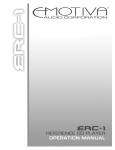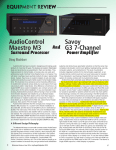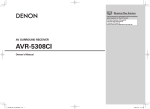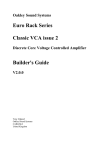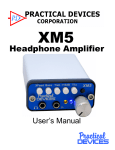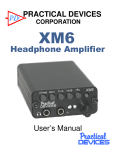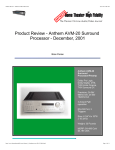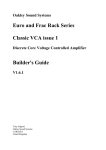Download Anthem - AVM 50v 3D 7.1 A/V Processor
Transcript
Product Review (July 2013) Anthem - AVM 50v 3D 7.1 A/V Processor By Kevin Nakano Anthem's highly acclaimed AVM 50v has now been upgraded to handle the latest 3D content with a small price increase from $6000 to $6500. Designated as the AVM 50v 3D, this feature-packed preamp/processor employs Dolby TrueHD, DTS-HD Master Audio, PCM 24/192 and continues to have 8 HDMI inputs (and 2 HDMI outputs) with the highest quality 1080p upscaling and 1080p24 compatibility. The new Anthem AVM 50v 3D can be configured to automatically detect the presence of a 3D video source and go into a transparent passthrough mode. In this mode, the output refresh rate is now automatically matched to the source’s frame refresh rate, which can be useful when the output switches between 24 and 60 Hz frame rates. The AVM 50v 3D measures 17.25"W x 6"H x 14.25"D and with the heavy-gauge non-resonant chassis weighs about 31 pounds. Front Panel The front of the AVM 50v 3D has an easy to read blue fluorescent display that works well in all lighting conditions. The controls are well organized with a single large knob for controlling volume, AM/FM tuning, setting adjustments, and setup for time and source naming. The Display button cycles through multiple brightness steps and can be turned off for completely dark theater settings. Just below the display are buttons for selecting radio stations and surround modes (Mode, Dynamics, and THX). There are four path buttons for Main, Zone 1, Zone 2, and Record on the upper left side. Just below these are the ten input source buttons. Across the front bottom are the tone controls (Bass, Treble, Bypass), Balance, Status, Mute, and the speaker groups (Sub-LFE, Surr-Rears, and Center) buttons. There are three power buttons for Main, Zone 1, and Zone 2 on the lower right side. Upgrading the original AVM50v to 3D Anthem offers existing AVM 50v owners the option to add 3D capability through a physical upgrade via a new dealer-installed circuit board which replaces two smaller boards for HDMI inputs 1 through 4 and HDMI output 1. This upgrade will also include a software update. Complementing the 3D switching and automatic passthrough features, the upgrade also provides the AVM 50v with video processor bypass for 2D, something useful for reference quality video content that doesn't require processing or scaling. Connections The back of the AVM 50v 3Dis impressive, with a nice selection of analog and digital interfaces to support state-of-the-art components as well as legacy products. Balanced two-channel analog inputs and balanced 7.1 outputs with additional zones/subs outputs provide the best performance. This unit accepts composite, s-video, and component video interfaces and upconverts them to as high as 1080p. Unbalanced (RCA) inputs and outputs are also available. Three optical (toslink) and seven coaxial digital input are provided along with an AES/EBU digital input. The 12-volt trigger outputs can be used to turn on other components such as power amplifiers. A pair of IR emitters and a terminal block for powered IR receivers is available. The RS232 port allows firmware updates to be performed by the user. The AM/FM antenna connections are made through an F-connector and a set of twin leads. Similar to other Anthem products we have seen, the detachable IEC input power jack does not have a ground pin, eliminating the problem of ground loops. There was no sign of any USB or ethernet interfaces, which is a bit surprising given the other advanced features and price point of the unit. HDMI Inputs The AVM 50v 3D provides eight HDMI inputs, but requires that 3D products be connected to HDMI inputs 1 through 4 with the 3D display connected to HDMI output 1. This has to do with the HDMI chips used within the unit. The HDMI switch time can be up to four seconds (2 seconds per stage). It should be noted that when 3D material is being received and the unit is in passthrough mode, the onscreen information (volume, etc.) is not overlayed on the display. Inside The Anthem AVM 50v 3Dcircuit boards are organized and partitioned to keep noise from affecting audio and video performance. The updated design has a new HDMI board that can pass 3D content to your projector or display. Board Layouts Anthem engineers worked hard on the board layout to optimize performance. The motherboard has 4-layers with separate power and groundplanes. The DSP, A/D and D/A boards use 6 and 8 layer designs with separate analog and digital planes, as well as separate power and groundplanes for remarkably low noise. In addition, all critical signal paths are surrounded by groundplanes.. Power The power supply design uses two power transformers totaling 115 VA with a low-radiating toroidal main transformer. The unit has 80,000 μf of power supply capacitance to provide the best filtration with 10 power supply regulation stages. The result is clean secondary power for sensitive electronics with unsurpassed low noise in the audio circuits. Audio The AVM 50v 3D includes a total of five, 2channel AK4382 24-Bit/192kHz DACs, which feature a delta-sigma converter with an 8-times interpolator on each channel operating at full 24bit, 192-kHz resolution. High performance operational amplifiers (Burr-Brown™ OPA-2134’s and Motorola® MC33078’s) are used in the signal path. The Burr Brown OPA2134 is a dual version of the highly regarded OPA134 series which provides ultra-low distortion and low noise with a true FET input stage making it ideal for high performance audio applications. Analog audio gets sampled and digitized using three dual-channel AK5383 ADCs capable of up to 24-bit x 96-kHz resolution. Audio-grade film capacitors and other high-precision thru-hole components are used for maximum audio performance. Even the headphone amplifier features a high-current/voltage design with a dedicated fully discrete output drive circuit. The Tone controls can also be bypassed (removes bass/treble completely out of the signal path) from the signal path. The audio levels are controlled using high performance Crystal CS3310 digital attenuators. For the audio purist, Anthem allows any of the analog audio inputs (including multi-channel inputs) to be routed through the DSP or completely bypassed. The XLR (True-Balanced) 2channel analog inputs provide the purest analog signal with built-in noise immunity. This level of flexibility offers audiophiles many options. Digital Signal Processing Anthem has their own precision Digital Signal Processing (DSP) design that leverages from the most powerful DSP engine in the industry, the FreeScale™ DSP 56367. This DSP provides precise decoding of the new HD audio standards including Dolby Digital Plus, Dolby TrueHD, DTSHD High-Resolution Audio and DTS-HD Master Audio, and is designed to process 24-bit audio. Video Processing Several HDMI chips are used in this design including Analog Devices' ADV7623 (4:1 HDMI receiver), Silicon Image's SiI9134 (HDMI transmitter) and SiI9135 (HDMI receiver), and Texas Instruments TMDS442 (4:2 HDMI switch). The high-quality video-switching circuits have their own independent, isolated circuit boards. The AVM 50v 3D uses the latest-generation Sigma Designs (formerly Gennum) VXP broadcast-quality digital image processor (supporting deep color) that converts any SD or HD video standard (including 1080p/24 or 1080p/60) to other video standards with full film detection and does an exceptional job with the video. The video decoder allows s-video and component video inputs to be digitally processed and enhanced and then routed through the component or HDMI outputs. The advanced video chip performs per-pixel processing and motion-adaptive de-interlacing to ensure optimal image sharpness and picture resolution while using dynamic directional interpolation to minimize jaggy and other motion artifacts. The quadruple video output configuration makes it easy to switch from one configuration to another. Each source can be independently adjusted for the best picture quality. Remotes The AVM 50v 3D remote provides users with a full size design with all the basic features needed to control the advanced A/V processor. The feel of the remote is not anything to get too excited about and is probably the one area Anthem could improve upon. The small text on the buttons is difficult to read with my aging eyes and the backlight does not help much. This is something I have come across on many of the higher-end products in general and is probably a result of most of these customers going to more advance controllers. Companies (like Anthem) may have decided that it does not make sense to spend development time and money on the remote when the majority of users will not use it. My Denon AVR5308CI remote also falls into this category and I found myself using an iPadbased menu system running RTI's control interface. On the upside, the remote is responsive and has good range. The dedicated input select buttons allow for fast access to the connected components. The universal design allows users to program and then control many of their components with this one remote. Dedicated button for 2-channel and 6-channel modes are provided. The remote runs from a pair of standard "AAA" batteries. Setup We had the opportunity to test this unit with some different equipment over the course of the review period. Our main configuration consisted of an OPPO BDP-105 Universal Blu-ray player for source material with the back-end handled by a Parasound HCA-2205AT 5-channel power amplifier. Speakers included a trio of M&K S150THX speakers to the front channels and a pair of M&K SS-250 surround speakers in the rear channels. We had the opportunity to test Ken Kreisel's new DXD-12012 and DXD-808 subwoofers in both Quattro and Duo configurations. The AVM 50v 3D allowed us to connect a single Quattro stack of four subwoofers or two Duo stacks using the balanced XLR connectors on the back panel. We also used a Dish Network Hopper HD satellite DVR as a practical source of VOD (Video On Demand) movies. Our Anthem LTX-500v projector (same as DLA-HD950) is mated to a 100-inch 16:9 Stewart FireHawk. We used Accell's UltraRun active HDMI cable between the AVM 50v 3Dand the projector that is mounted in the back of the room. The walls are covered withEcho Buster sound absorption panels to help eliminate slap echo and significantly reduce the RT60 time in the room. Secondary reflections, which often blur the sonic image are largely reduced or eliminated with these panels. Firmware Updates The review unit came with firmware v3.01 and the website indicated v3.09 was available. We decided to update the AVM 50v firmware to get the latest changes into our review. Using the supplied Tripp Lite USB to serial adapter connected to the RS232 port on the back of the unit, we downloaded the latest firmware (AVM 50v Software v3.09) from theAnthem A/V website and programmed the AVM 50v using our laptop. Main Menu The menu system on theAVM 50v is a rather plain looking user interface that better resembles a VCR and not a high-end A/V processor. Regardless, it gets the job done and provides the controls to configure the system. The menus are partitioned into eight sections. Each of the sources can have custom names which makes it easier to select. Video Adjust Menu The Video Adjustment menu on the AVM 50v 3D gives the user an extensive amount of adjustability for each of the video inputs. This allows for picture optimization including cropping, aspect ratio control, chroma bug filter, gamma correction, noise reduction, detail enhancement, as well as other video processing. All functions are available for HD inputs and onscreen displays are shown through HDMI and component video. The look of this menu is much more appealing to view than the basic user interface. Anthem Room Correction Anthem has become well known for their ARC (Anthem Room Correction) system because it works so well. We first experienced ARC when we reviewed theMRX 700 last year. The ARC kit comes packaged in a separate box that includes a USB microphone, sturdy tripod with boom, USB cable, RS232 cable, software, and instructions. The cables are long, so users should have plenty of length for a variety of room layouts as long as a laptop is handy. Since most modern-day laptops do not have RS232 serial ports, Anthem provided a Keyspan (model USA-19HS) USB-toserial adapter that can be used for both room correction and firmware upgrades. The calibration microphone (via USB) and theAVM 50v 3D both plug into the laptop. The tripod is fully adjustable allowing for virtually any simulated seating position. Anthem requires the microphone to point straight up where the listener's head would normally be positioned. Anthem's Room Correction (ARC) system makes use of proprietary processes and the power of your PC to analyze each speaker’s in-room response. The software collects data and computes the required correction to yield optimal performance by analyzing each speaker's in-room response and setting output levels, crossover frequencies and room correction parameters accordingly. This applies to each of the speakers being measured. The process takes less than 5 minutes and the improvement in performance is substantial on an already excellent system. ARC provides separate corrections for music and movies. Graphic Results Once ARC runs through the system, the collected data is then processed by the computer running ARC and finally transfers the post-processed data back into theAVM 50v 3D. The advantage of this system is that it relies on the computer, which has lots of floating point processing power, memory and storage space to calculate the correction curves to a high degree of accuracy. The ARC design makes a lot of sense and the performance we experienced with the room correction was excellent. The nice part about running the correction algorithms on the laptop is that you can see the results in graphic form. Once the ARC process completes, a frequency response chart (dB versus Frequency) with three plots formeasured (red line), calculated (blue line), and target (dotted line) are displayed for each of the channels. This is purely a frequency graph and does not indicate any time delay corrections applied to the channels. Users can either run a fully automated ARC or go manual.






